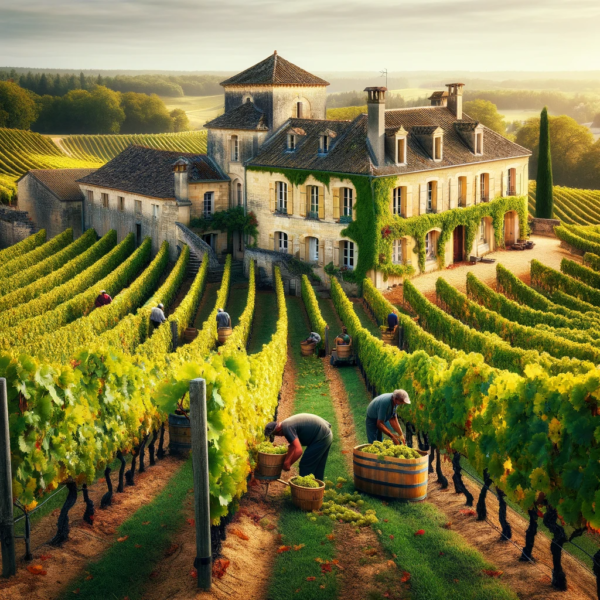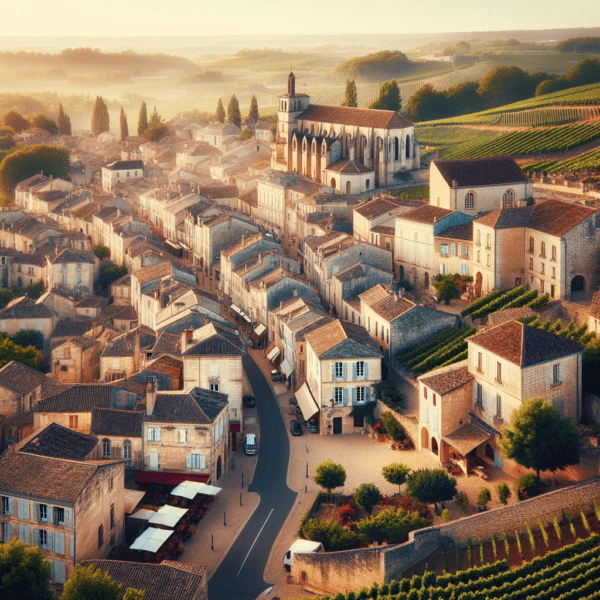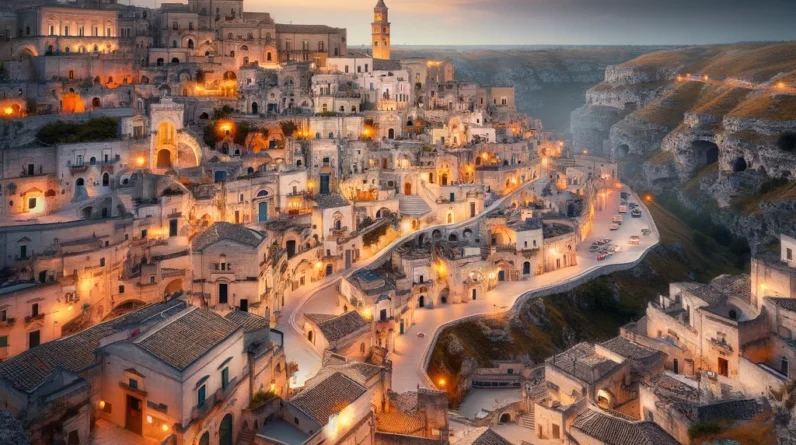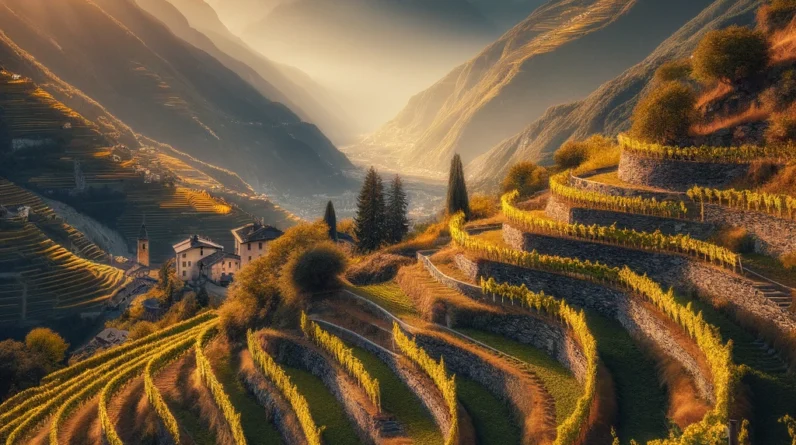
The Hidden Gems of Saint-Émilion: Exploring Its Sub-Appellations
The Saint-Émilion region, a jewel in the crown of Bordeaux’s wine country, is renowned globally for its exquisite wines.
However, beyond the fame of Saint-Émilion, lie its sub-appellations – hidden gems that offer exceptional wines often overshadowed by their illustrious neighbor.
In this article, we delve into these sub-appellations, exploring the unique qualities that make each of them a treasure trove for wine enthusiasts.

Lussac Saint-Émilion: The Approachable Elegance
Starting our journey in Lussac Saint-Émilion, this sub-appellation is known for its full-bodied and rich wines.
Dominated by Merlot, the wines here balance fruit, tannins, and acidity beautifully, creating an approachable yet complex profile.
The charm of Lussac Saint-Émilion lies in its ability to offer an authentic Bordeaux experience, combining quality and affordability.
The wines are perfect for those venturing into the Bordeaux region, offering a taste of tradition without the intimidation of grandeur.
Predominant Grapes: Merlot, Cabernet Franc, Cabernet Sauvignon
Notable Vineyards: Château de Barbe Blanche, Château Lyonnat Lussac Saint-Émilion wines are known for their full-bodied richness.
The dominant Merlot grape lends a soft and fruity profile, while Cabernet Franc adds structure and complexity.
Château de Barbe Blanche, for instance, is renowned for its elegant wines that beautifully express the terroir.
Château Lyonnat, another jewel, offers wines that are a symphony of balance and depth, embodying the appellation’s approachable elegance.

Puisseguin Saint-Émilion: The Underdog’s Triumph
Next, Puisseguin Saint-Émilion stands as a testament to the underdog.
This sub-appellation produces Merlot-based wines that are robust and layered, often revealing dark fruit flavors and earthy undertones.
The soils, rich in clay and limestone, contribute significantly to the wines’ depth.
Puisseguin Saint-Émilion is an emblem of quality and value, ideal for discerning palates seeking the Saint-Émilion experience with a unique twist.
Predominant Grapes: Merlot, Cabernet Franc, Cabernet Sauvignon
Notable Vineyards: Château Rigaud, Château Haut-Saint-Clair In Puisseguin Saint-Émilion, Merlot takes the lead, creating robust and layered wines.
Château Rigaud is a standout, producing wines that capture the essence of the appellation with their rich and full-bodied character.
Château Haut-Saint-Clair is known for its skillful blend of tradition and innovation, resulting in wines that are both classic and contemporary.

Saint-Georges Saint-Émilion: The Hidden Masterpiece
Saint-Georges Saint-Émilion, though smaller in size, is remarkable in its wine production.
The wines here are noted for their elegance and aging potential, showcasing a rich tannic structure and a bouquet of flavors ranging from ripe berries to subtle spices.
This sub-appellation is a hidden masterpiece, offering wines that rival the best of Saint-Émilion at more modest prices.
Predominant Grapes: Merlot, Cabernet Franc.
Notable Vineyards: Château Macquin, Château Cap Saint-George.
The wines of Saint-Georges Saint-Émilion, primarily Merlot with touches of Cabernet Franc, are celebrated for their finesse.
Château Macquin stands out for its wines that showcase a perfect harmony of fruit and structure.
Château Cap Saint-George is another notable name, offering wines that reflect the unique character of this small but prestigious sub-appellation.

Montagne Saint-Émilion: The Rustic Charm
Montagne Saint-Émilion, often overlooked, deserves its moment in the spotlight.
The wines from this area are characterized by their rustic charm and depth.
The vineyards, benefiting from diverse terroirs, produce wines that are both powerful and nuanced, often with a delightful balance of fruit and earthy notes.
Montagne Saint-Émilion is for those who appreciate the nuances of terroir and seek a deeper, more rustic experience.
Predominant Grapes: Merlot, Cabernet Franc, Cabernet Sauvignon.
Notable Vineyards: Château La Grande Clotte, Château Fongaban In Montagne Saint-Émilion.
The blend of Merlot, Cabernet Franc, and Cabernet Sauvignon creates wines with a rustic yet refined profile.
Château La Grande Clotte is a beacon of excellence, known for its expressive and harmonious wines.
Château Fongaban stands as a testament to the appellation’s ability to produce wines with depth and complexity.
| Sub-Appellation | Grapes | Soils | Climate | Notable Vineyards | Known For |
|---|---|---|---|---|---|
| Lussac Saint-Émilion
| Merlot, Cabernet Franc, Cabernet Sauvignon | Clay, limestone, sandstone | Moderate, maritime | Château de Barbe Blanche, Château Lyonnat | Full-bodied and rich wines, approachable elegance |
| Puisseguin Saint-Émilion
| Merlot, Cabernet Franc, Cabernet Sauvignon | Clay, limestone | Moderate, maritime | Château Rigaud, Château Haut-Saint-Clair | Robust, layered wines, excellent value |
| Saint-Georges Saint-Émilion
| Merlot, Cabernet Franc | Clay, limestone, iron deposits | Moderate, maritime | Château Macquin, Château Cap Saint-George | Finesse and aging potential, elegant wines |
| Montagne Saint-Émilion
| Merlot, Cabernet Franc, Cabernet Sauvignon | Clay, limestone, sand | Moderate, maritime | Château La Grande Clotte, Château Fongaban | Rustic yet refined profile, expressive wines |

Visiting the Sub-appellations of Saint-Emilion
When visiting the sub-appellations of Saint-Émilion, there are several key experiences and sights you definitely shouldn’t miss.
These highlights will enrich your journey and provide a deeper understanding and appreciation of the region’s wine culture and heritage.
Iconic Vineyard Tours
Historic Châteaux: Visit some of the most iconic vineyards and châteaux in each sub-appellation. Look for those with historical significance or unique winemaking techniques.
Family-Run Estates: Explore smaller, family-run estates for a more intimate insight into winemaking.
Wine Tasting Sessions
Vertical Tastings: Participate in vertical tastings (tasting the same wine from different vintages) to understand the aging process and variation across years.
Food and Wine Pairings: Experience guided food and wine pairings to appreciate the synergy between local cuisine and wines.
Exploring Saint-Émilion Town
Underground Monolithic Church: Discover the impressive underground church carved out of solid limestone.
Cobbled Streets and Medieval Architecture: Wander the charming cobbled streets of Saint-Émilion, soaking in the medieval ambiance.
Cultural Activities
Wine Workshops and Classes: Engage in wine education sessions or workshops to deepen your wine knowledge.
Local Festivals: If your visit coincides with a local wine festival or harvest event, it’s a must-attend for a truly local experience.
Gastronomic Delights
Michelin-Starred Restaurants: Indulge in a meal at one of the region’s Michelin-starred restaurants for a memorable gastronomic experience.
Local Markets and Artisanal Products: Sample and purchase local products like cheeses, truffles, and pastries.
Scenic Beauty and Leisure
Vineyard Picnics: Enjoy a picnic in a scenic vineyard setting, a perfect way to relax and savor the local produce and wines.
Bicycle Tours: Take a bicycle tour through the vineyards for a picturesque and engaging way to see the countryside.
Nearby Attractions
Bordeaux City: A trip to the nearby city of Bordeaux, with its rich history and vibrant wine culture, is highly recommended.
Dordogne River Excursions: Consider a boat trip along the Dordogne River for stunning views of the region.
The sub-appellations of Saint-Émilion are not just destinations; they are experiences that engage all your senses.
From the taste of finely aged wines to the sight of ancient vineyards, and from the aroma of French cuisine to the touch of historic stones, each moment here is to be savored.
Make sure not to miss these highlights to fully embrace the spirit and essence of this extraordinary wine region.
Practical Tips on Visiting the Sub-appellations of Saint-Emilion
Visiting the sub-appellations of Saint-Émilion is an enchanting experience for any wine enthusiast.
Here are some general guidelines to help you make the most of your journey through these captivating wine regions.
Planning Your Trip
Timing: The best times to visit are late spring (May-June) or early fall (September-October) for pleasant weather and fewer crowds. Harvest season (September-October) is particularly exciting.
Accommodations: Consider staying in Saint-Émilion town for easy access to all sub-appellations. There are charming bed and breakfasts, boutique hotels, and vineyard estates offering lodging.
Exploring the Vineyards
Book in Advance: Many vineyards require appointments for tours and tastings, so book ahead.
Diverse Experiences: Each sub-appellation offers unique experiences. Lussac and Montagne are great for rustic charm, while Puisseguin and Saint-Georges offer more intimate settings.
Guided Tours: Consider guided tours, especially if you’re interested in learning about the history and wine-making process in depth.
Tasting and Buying Wine
Tasting Etiquette: Be open to trying different wines, and remember, it’s okay to spit wine out after tasting.
Purchasing Wine: Buying wine directly from vineyards can be a great way to get unique bottles, and many vineyards ship internationally.
Food and Dining
Local Cuisine: Explore local restaurants and bistros. The region is known for its exquisite French cuisine, perfectly paired with local wines.
Picnics: Some vineyards allow or even encourage picnics on their grounds, offering a delightful way to enjoy wine with local produce.
Cultural and Historical Sites
Visit Saint-Émilion Town: This UNESCO World Heritage Site is rich in history, with stunning architecture and ancient wine cellars.
Local Markets: Check out local markets for regional delicacies, crafts, and fresh produce.
Getting Around
Rental Car: A rental car offers the most flexibility for exploring the countryside.
Biking: For the more adventurous, biking through the vineyards can be a delightful way to see the region.
Wine Tours: Several companies offer wine tours that handle transportation and provide an educational component.
Respecting the Region
Sustainability: Be mindful of the environment; respect vineyard properties and dispose of waste properly.
Supporting Local Businesses: Buy from local artisans and producers to support the local economy.
Language and Communication
Basic French: Knowing basic French phrases is helpful, although many wineries have English-speaking staff.
Guides: Consider hiring a local guide if you’re not comfortable with the language.
Visiting the sub-appellations of Saint-Émilion is not just about wine tasting; it’s about immersing yourself in the rich culture, history, and beauty of the region.
Each vineyard and village has its own story to tell, making this journey a truly unforgettable experience.
Prepare to be captivated by the landscapes, the people, and, of course, the exquisite wines of this remarkable area of Bordeaux.
The sub-appellations of Saint-Émilion are more than just extensions of their famous parent; they are regions with their own identities, stories, and exceptional wines.
Exploring these areas offers a journey through the diverse landscape of Bordeaux’s wine country, revealing the hidden gems that lie within.
Whether you’re a seasoned connoisseur or a curious newcomer, the sub-appellations of Saint-Émilion are a treasure trove waiting to be discovered.
FAQs:
Q1: What are the main sub-appellations of Saint-Émilion?
A1: The main sub-appellations of Saint-Émilion include Lussac Saint-Émilion, Puisseguin Saint-Émilion, Saint-Georges Saint-Émilion, and Montagne Saint-Émilion.
Q2: What types of grapes are grown in these sub-appellations?
A2: The predominant grape variety in these sub-appellations is Merlot, often blended with Cabernet Franc and Cabernet Sauvignon.
Q3: Are the wines from these sub-appellations similar to those from Saint-Émilion?
A3: Yes, the wines share similarities due to comparable terroir and grape varieties, but each sub-appellation also has its unique characteristics and wine styles.
Q4: Do I need to book vineyard tours in advance?
A4: Yes, it’s highly recommended to book vineyard tours in advance, as many vineyards in these regions require appointments for tours and tastings.
Q5: Can I visit the sub-appellations using public transport?
A5: While possible, public transport options are limited. It’s more convenient to rent a car or join a guided wine tour for ease of travel.
Q6: Are there accommodations within the sub-appellations?
A6: Yes, there are various accommodations, including bed and breakfasts, boutique hotels, and vineyard estates offering unique lodging experiences.
Q7: What is the best time of year to visit these sub-appellations?
A7: The best times to visit are late spring (May-June) or early fall (September-October) for pleasant weather and fewer crowds.
Q8: Can I purchase wine directly from the vineyards?
A8: Yes, many vineyards offer the option to purchase wine directly, and some even provide international shipping services.
Q9: Is there a language barrier for non-French speakers?
A9: While basic French is helpful, many wineries in these regions have English-speaking staff. Hiring a local guide can also enhance your experience.
Q10: Are there any cultural or historical sites to visit in addition to vineyards?
A10: Absolutely! The town of Saint-Émilion, a UNESCO World Heritage Site, is a must-visit for its rich history and stunning medieval architecture.

Elevate Your Wine Journey with the Wine Folly Tasting Journal: A Chronicle of Flavors and Memories!
🍷 Capture Every Sip and Swirl in Elegant Detail! 📖
For wine lovers who cherish every tasting experience, the Wine Folly Tasting Journal is an essential companion. This elegantly designed journal is more than just a notebook – it’s a personal memoir of your wine journey.
📘 Features of the Journal:
- Sophisticated Cover Design: A beautiful and durable cover that encapsulates the essence of wine exploration.
- Structured Tasting Sections: Thoughtfully organized pages to record your tasting notes, ratings, and memories.
- Tips and Guides: Helpful hints on how to taste wine and identify flavors, enhancing your sensory experience.
🌄 Set Against the Serene Backdrop of Vineyards, this journal is perfect for use in a cozy wine tasting room or during a tranquil evening at home. It invites you to delve deeper into your wine tasting adventures, transforming each glass into a story to be chronicled.
🍾 Why Choose Our Tasting Journal?
- Deepen Your Wine Knowledge: Track and compare your tastings, developing a more refined palate over time.
- Create Lasting Memories: Look back on your wine experiences with fondness and detail.
- Perfect for All Wine Enthusiasts: Whether you’re a novice or a seasoned taster, this journal caters to all levels of wine appreciation.
📚 Transform Your Tastings into Treasured Moments: The Wine Folly Tasting Journal is not just a tool; it’s a treasure trove of your wine experiences.
🎁 An Ideal Gift for Wine Aficionados: Surprise the wine lover in your life with a gift that’s both practical and thoughtful.
🔗 Discover the Wine Folly Tasting Journal on Amazon
🥂 Here’s to Memories One Glass at a Time – Happy Tasting!







